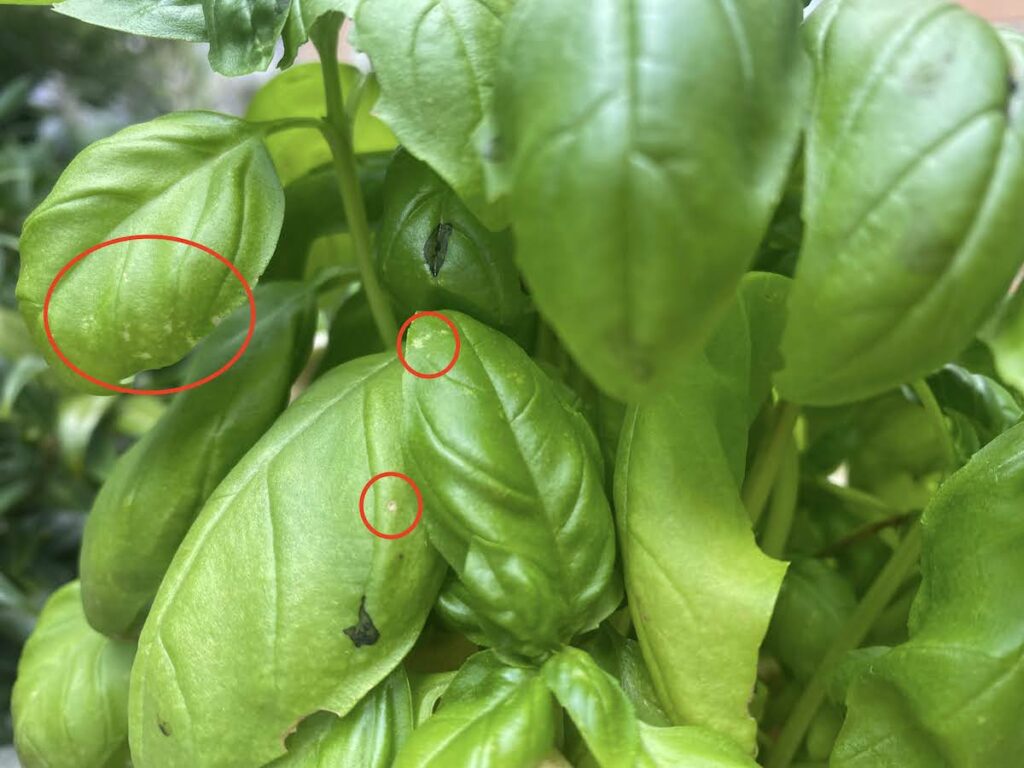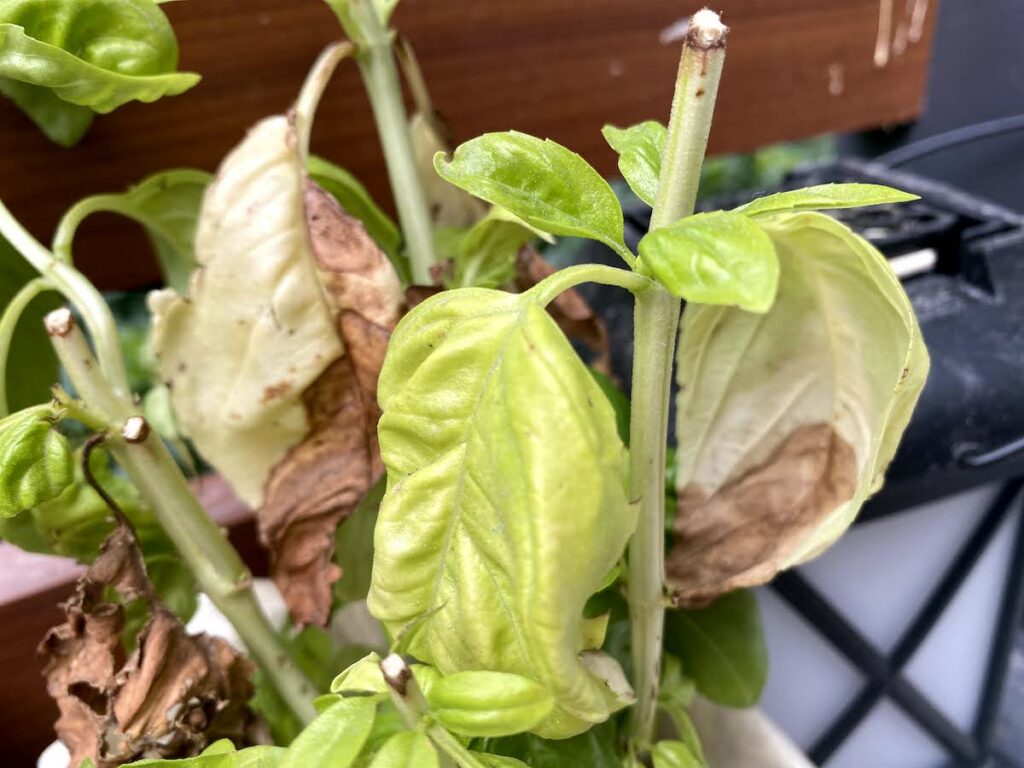As an Amazon Associate I earn from qualifying purchases. This website also participates in other affiliate programs and may earn commissions if you shop through the links used on this website.
(This article was originally published on September 1, 2022 and was last updated on September 3, 2022)
Are your basil leaves turning yellow on the plant? If so, we can help! In this article, we explore 5 potential causes for yellow basil leaves, and a few tips for fixing the underlying problem.
Luscious, green, flavorful basil leaves make a lovely addition to your garden (and your plate!) It is also a relatively easy herb to grow indoors or out, and from seed, from cuttings you take from a mature plant, or plant starts. This makes it a favorite addition to many herb gardens. But even the most experienced gardener has to deal with the occasional problems plaguing their basil plants.
One of the most common issues is basil leaves turning yellow.

It can be a heartbreaking discovery to find black spots or patches, white stuff, huge gaping holes, brown areas on the leaves, or yellowing after you put so much care into your basil plants. But don’t worry. In most cases, there are easy, available solutions so you can stop your basil plants from developing yellow leaves.
Read on to discover 5 potential reasons basil leaves turn yellow, and how to address them.
As long as you closely monitor and care for your plants, you can potentially save your basil harvest even after discovering the leaves turning yellow.
What Are the Causes of Yellowing Basil Leaves?
Several potential underlying factors can cause yellow basil leaves. It will take some time to investigate and determine the root cause. Take a look at each of the items below. One of these is most likely the culprit. After discovering why your basil leaves are turning yellow, you should ultimately find a solution to protect them from future damage.
Pest Infestation on Your Basil Plants
A few insect species love basil as much as you do. So, if your basil leaves are suddenly yellow, you may very well have a pest problem.
Aphids (and Spider Mites, too)
One species that particularly enjoys munching on your basil leaves is aphids.
Aphids are tiny, with most species coming in at no more than 2-4mm in length. They have pear-shaped bodies and range in color from black, red, green, white, or yellow.
Often you will not notice aphids feasting on the juice from your basil leaves until you spot yellowing leaves. That is because aphids primarily hang out on the underside of the leaves and the juncture where the leaves and stem connect. Their preferred hiding places can prevent early detection.

Thankfully, aphids are relatively easy to get rid of. There are some products you can buy at the store if you wish. These include insecticidal soap and neem oil.
However, you can also mix up a simple solution of dish soap, warm water, and cayenne. Spray or rub the mixture onto the leaves of your basil, including the underside. Re-apply for a few days to ensure you have coated all surfaces, just make sure you wash the leaves thoroughly before eating them!
Spider mites can also cause the small yellow spots on basil leaves caused by sucking out all the delicious leaf juices, and can be taken care of just as you would with aphids.

Leafhoppers
Another insect that causes yellowing leaves on basil is leafhoppers. They are slightly larger than aphids and measure around 6mm in length.
Just like aphids, leafhoppers like to cluster on the underside of basil leaves. And they have a particular affinity for the sap inside the leaves. They will suck out this tasty juice, which leaves you with yellow basil leaves, rather than the bright green or vibrant purple you were probably hoping for.
Other indicators that leafhoppers are the culprit for your basil turning yellow include curling basil leaves or a scorched appearance along the edges.
Use the same treatment methods recommended above for aphids to stop a leafhopper infestation.
A Basil Plant with Poor Growing Conditions
Inadequate Soil
Yellow leaves could be a sign your basil is suffering from a lack of nutrients or is growing in poor soil, or soil with the wrong ph levels.
Basil loves high-quality, fertile soil, so start with a good quality potting soil to give your basil plant the best shot at healthy growth, and make sure it’s growing in a large enough pot to have adequate soil nutrition.
Nutrient deficiency can cause basil’s vibrant green color to wane, replaced with a noticeable yellowing of the leaves. Nitrogen deficiency results in yellowing leaves in basil, as does potassium deficiency, sulfur deficiency, and iron deficiency.
Soil ph can impact the available nutrients for the plant, so ensure your soil ph is relatively neutral, between 6 and 7.5, and ideally right around 7, as too alkaline soil or too acidic soil will result in a lack of nutrients for the plant.

The plants also need an abundant and regular supply of nutrition to grow large, beautiful leaves. Make sure to apply nitrogen and potassium rich fertilizer every month or so for basil planted in your garden.
You may need to fertilize up to twice a month if growing your basil in a container or hydroponically. Opt for a liquid fertilizer if possible, as they are more readily and rapidly absorbed.
Temperature
As spring approaches, we are all eager to get our garden started. But try to fight the urge to plant your basil too early. Basil plants are perennial plants that require warmer conditions, and don’t do well in frost or winter. If the weather is too cold, you might find the basil leaves turn yellow or another color, or wilt and droop as a sign of stress. The ideal temperature for basil is at least 50F overnight and 70F during the day.
Note Enough Direct Sunlight
Basil plants adore sunny conditions and require ample light to develop their stunning green leaves. Plant them in a warm and sunny location. Basil plants require a minimum of 6 hours of direct sunlight every day, and you may find your basil leaves turn yellow if they don’t get enough sun.
If you are growing your basil indoors, it likely will not get adequate sunlight. Consider supplementing with an LED grow light. You will want to increase their light exposure under grow lights, however. Keep it shining on your basil plants for 10-12 hours to offer optimal growing conditions.
Incorrect Watering Practices
It takes a little time to determine how much water your basil plant needs. External factors such as intense sunlight, high heat, or colder weather can all influence the amount of watering you need to do.
Your basil plant will be the happiest when it has consistently moist soil for its roots. It does not handle dry soil well. Nor does it like overly boggy, soggy or waterlogged soil conditions. Often, yellow leaves on basil plants are due to over watering rather than under watering.
Extremely wet conditions can also lead to a problem called root rot. When a basil plant’s roots get excessively wet and remain so, the root system will simply start rotting away. Ultimately, the root rot will cause the plant itself to start dying off.
Potted basil plants are especially tricky, as container grown basil requires more frequent watering, on the one hand, but is also more prone to overwatering and will require some extra attention to prevent yellow basil leaves. Make sure your potted basil is growing in containers with adequate drainage holes, as this will help.
If you’re unsure whether your basil plant needs watering, stick your finger into the soil roughly an inch or two deep. Provided the soil is moist at that depth, you do not need to add additional water.
Diseases
To keep your basil plants happy and healthy, you need to allow them to have proper air circulation. If the plants are too crowded, and the leaves cannot fully dry out or you’re in a highly humid environment, they can develop diseases.
Avoiding a crowded growing area is quick and easy. Plant your basil approximately 8-12″ ( ) apart. Doing so will give your plants plenty of room to stretch their leaves.
Downy Mildew
A common disease plaguing basil plants is known as downy mildew. When downy mildew strikes your basil leaves, it causes a yellowing leaves with gray spots.
Downy mildly spreads extremely rapidly. If you catch it early and remove the affected leaves, you may be able to save the rest of your plant. Unfortunately, if the downy mildew has infected a large portion of the leaves, you will want to remove and dispose of the plant.
Take care when removing plants infected with downy mildew. You want to avoid brushing it against other plants to prevent this fungal disease from spreading further.
If you have plants with downy mildew, don’t let them flower or collect the seeds to grow from seed next year, as it can be transmitted via seeds.
Can You Eat Yellow Basil Leaves?
We recommend you don’t eat yellow basil leaves, especially if you’re not entirely sure the cause. At worst, you’ll end up consuming some fungus, bacteria, or insect residue, and at best it simply won’t be as tasty. When you have a basil recipe, harvest healthy and vibrant leaves for the tastiest and safest results.
Final Thoughts
Discovering yellow leaves on your basil plants is concerning. After all, you have put a lot of care and attention into growing big, bushy plants. But don’t despair. Most of the reasons basil leaves turn yellow have simple remedies.
Once you have determined what the underlying cause is, you can take steps to address it. And if you catch the problem early enough, and remove the affected leaves through careful pruning, you can continue harvesting tasty basil leaves through the remainder of the growing season.
After successfully solving the mystery of yellow basil leaves, you should treat yourself to some basil-inspired goodness. Consider adding basil leaves to a brand new meal, such as one of these Thai dishes. Or invite your friends over for appetizers and drinks showcasing your homegrown basil.
Jennifer is a writer, Nutritionist, and Herbalist who loves all things food. She grows basil alongside other herbs and edible flowers in her garden. Herbs also hold a prominent space in her aerogarden. She enjoys experimenting in the kitchen, finding fun and unique ways to incorporate herbs into daily life. Jennifer is passionate about helping others discover the joy of quality food. And she loves to bring her two kids along on endless food adventures!

